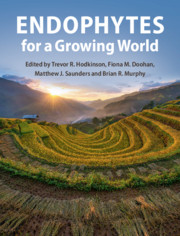Book contents
- Endophytes for a Growing World
- Endophytes for a Growing World
- Copyright page
- Contents
- Contributors
- Preface
- Part I Introduction
- Part II Role of Endophytes in Growth and Biotic and Abiotic Stress Resistance
- 2 Searching for Novel Fungal Biological Control Agents for Plant Disease Control Among Endophytes
- 3 Application of Formulated Endophytic Entomopathogenic Fungi for Novel Plant Protection Strategies
- 4 Crossing Frontiers: Endophytic Entomopathogenic Fungi for Biological Control of Plant Diseases
- 5 Emerging Methods for Biological Control of Barley Diseases Including the Role of Endophytes
- 6 Phosphate Nutrition in Root–Fungus Interactions
- 7 From Darkness to Light: Emergence of the Mysterious Dark Septate Endophytes in Plant Growth Promotion and Stress Alleviation
- Part III Diversity and Community Ecology of Endophytes
- Part IV Endophytes for Novel Biomolecules and In Vitro Methods
- Part V Application and Commercialisation of Endophytes in Crop Production
- Index
- References
3 - Application of Formulated Endophytic Entomopathogenic Fungi for Novel Plant Protection Strategies
from Part II - Role of Endophytes in Growth and Biotic and Abiotic Stress Resistance
Published online by Cambridge University Press: 01 April 2019
- Endophytes for a Growing World
- Endophytes for a Growing World
- Copyright page
- Contents
- Contributors
- Preface
- Part I Introduction
- Part II Role of Endophytes in Growth and Biotic and Abiotic Stress Resistance
- 2 Searching for Novel Fungal Biological Control Agents for Plant Disease Control Among Endophytes
- 3 Application of Formulated Endophytic Entomopathogenic Fungi for Novel Plant Protection Strategies
- 4 Crossing Frontiers: Endophytic Entomopathogenic Fungi for Biological Control of Plant Diseases
- 5 Emerging Methods for Biological Control of Barley Diseases Including the Role of Endophytes
- 6 Phosphate Nutrition in Root–Fungus Interactions
- 7 From Darkness to Light: Emergence of the Mysterious Dark Septate Endophytes in Plant Growth Promotion and Stress Alleviation
- Part III Diversity and Community Ecology of Endophytes
- Part IV Endophytes for Novel Biomolecules and In Vitro Methods
- Part V Application and Commercialisation of Endophytes in Crop Production
- Index
- References
Summary
In recent years, research into novel plant protection strategies with endophytic entomopathogenic fungi has increased markedly. However, current applications of these fungi are mostly not supported by targeted formulation strategies which should enhance fungal establishment in close proximity to plant tissue and promote endophytism. Further drawbacks are low stability of fungal propagules during drying and storage, difficult handling as well as high dosages and costs per hectare. Formulation has the potential to substantially improve all of these characteristics to come closer to implementation of these fungi in integrated pest management. This chapter reviews the currently available literature on application of formulated endophytic entomopathogenic fungi via sprays, seed treatments, and sowing of granules and beads. It further addresses future trends in formulation science to overcome current challenges of endophytic entomopathogenic fungi regarding consistent efficacy particularly under field conditions.
- Type
- Chapter
- Information
- Endophytes for a Growing World , pp. 52 - 66Publisher: Cambridge University PressPrint publication year: 2019

